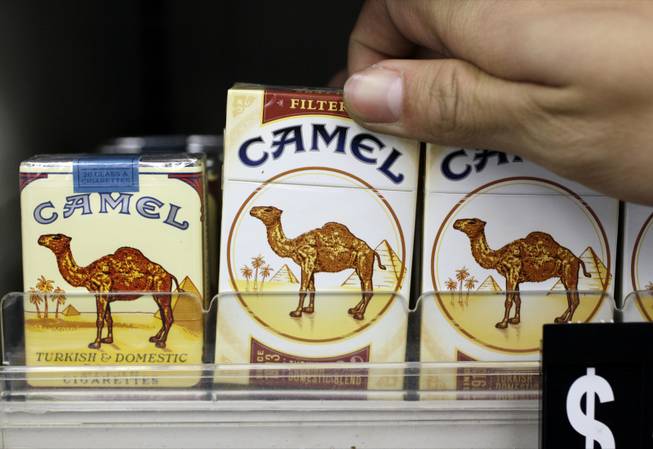
Paul Sakuma / AP
In this Feb. 1, 2011, photo, Camel cigarettes, an R.J. Reynolds product, are on display at a liquor store.
Thursday, Jan. 25, 2018 | 2 a.m.
The American Lung Association’s 2018 State of Tobacco Control report, which grades states on policies to prevent and reduce tobacco use, shows that Nevada lags in anti-tobacco measures.
The 16th annual report graded states in five categories, with Nevada receiving four F's and a C. It received an F in tobacco prevention and control program funding, tobacco taxes, access to cessation services and minimum age. The state got a C in the Smoke Free Air category.
“It’s not one of our best qualities for sure,” said Will Rucker, director of programs for the American Lung Association in Nevada. “The grades we received is nothing new — we’ve not done well in the past.”
Nevada’s leading cause of preventable death is tied to tobacco use, with 4,050 deaths attributed to smoking between 2005-2009, the study showed. The state sees $1.08 billion in health care costs due to smoking each year.
Some geographic areas and population groups — such as people who live in rural areas, those with mental illness and minorities — face the greatest risk for tobacco-related death and illness, Rucker said.
“That goes to the health care question, because these people don’t have access to the health care system in the way that other groups do,” he said. “Everyone deserves a chance to be fully healthy and have access to great health care.”
The report urges Gov. Brian Sandoval and state lawmakers to pass comprehensive smoke-free laws and increase funding for tobacco prevention and control programs. In 2017, Nevada earmarked $950,000 in state funds, on top of $927,208 federal funding, for tobacco prevention and cessation programs, which the study said is well under what is necessary to prevent and reduce tobacco use in the state.
The Centers for Disease Control recommends Nevada spend $30 million on tobacco prevention and cessation programs. Nevada spends $1.87 million annually, or just 6.3 percent of the recommended amount.
“One of the reasons we have not made much progress on the areas we’re focusing on is simply lack of funding,” Rucker said. “Funding is grossly misappropriated. Our dollars that go toward tobacco control are very minimal compared to other states.”
Despite what the study suggested, Sandoval’s office said he’s spearheaded several initiatives aimed at curbing tobacco use.
“The governor has championed multiple policies which have contributed to more Nevadans living healthier, happier lives. Currently the Department of Health and Human Services is exploring federal financial participation to match Medicaid funds to curb tobacco use,” said Mari St. Martin, Sandoval’s spokesperson. “Additionally, because the governor opted into the Medicaid expansion, more Nevadans have access to Managed Care Organization’s tobacco prevention programs and the state is also administering more block grant funding specifically targeting youth tobacco prevention efforts.”
During the 2015 legislative session, Sandoval signed into law a bill increasing the cigarette tax by $1 per pack with the intention of reducing cigarette use, St. Martin said. Smoking sales in Nevada, everything from chewing tobacco to cigarettes, are at $245 million per year.
Protecting and expanding the Nevada Clean Air Act, prohibiting smoking in all indoor structures, is a key part to improving the state’s grade on the report, Rucker said. That could be easier said than in a state that relies heavily on gaming and a gambler’s desire to smoke and drink while playing.
“Smoke-free laws don’t hurt business,” he said. “Just because (smoking) is part of our culture here, it’s doesn’t mean it has to stay that way.”
California graded out the best in the report with three A’s, two B’s and a C. Four states — Mississippi, North Carolina, Texas and Virginia — received all F’s.
